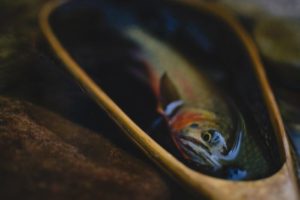

1. Go Fishing More

It’s simple: Capturing a great fly fishing photo often means that you happen to be in the right place at the right time. The more you fish, the more you’ll happen to find yourself in the incredible moments to photograph.
As your time in the field expands, you will clue in on aspects to shoot, like the way the last light of a day filters through the pines at a fishing hole or the precise moment of the annual hatch.
Fish more, learn your zones, and use the knowledge to your advantage. You’ll be prepared and ready when the moment presents itself.
2. Invest in a DSLR or Mirrorless Camera Body and Quality Lens
I primarily shoot on a Nikon D500. But there are many other entry-level camera bodies that work great and won’t break the bank. I used to shoot with a Nikon D5200, which you can find used online for less than $400.
While your camera body is important, it’s far more critical to have a nice lens. I shoot with an array of lenses ranging from 9 to 200 mm. My go-to lens is the Nikon 35mm f/1.8 prime lens. This lens is tack sharp and relatively affordable.
The large aperture creates a shallow depth of field and creamy bokeh and allows the photographer to shoot in low light without sacrificing shutter speed or cranking the ISO.



